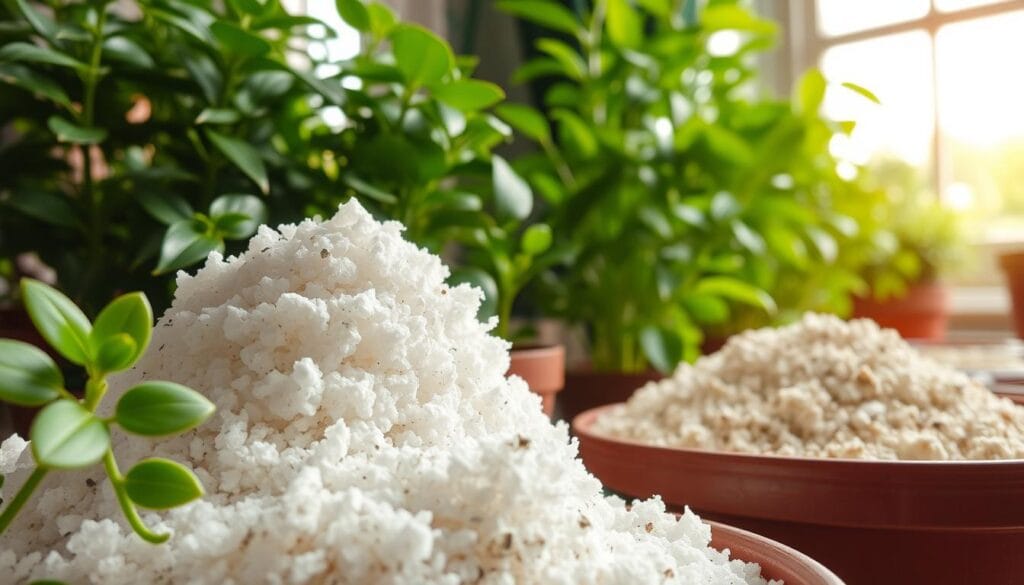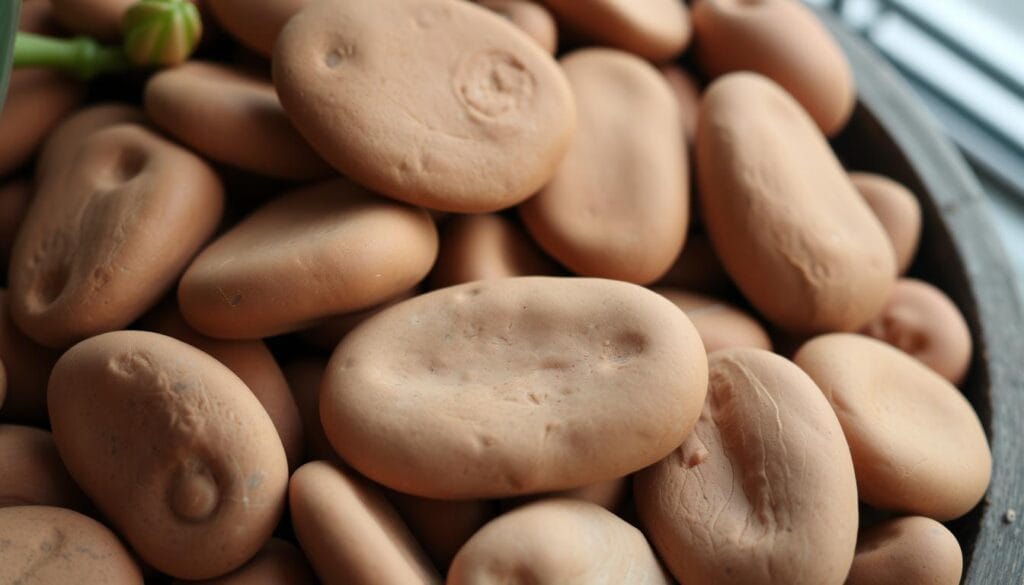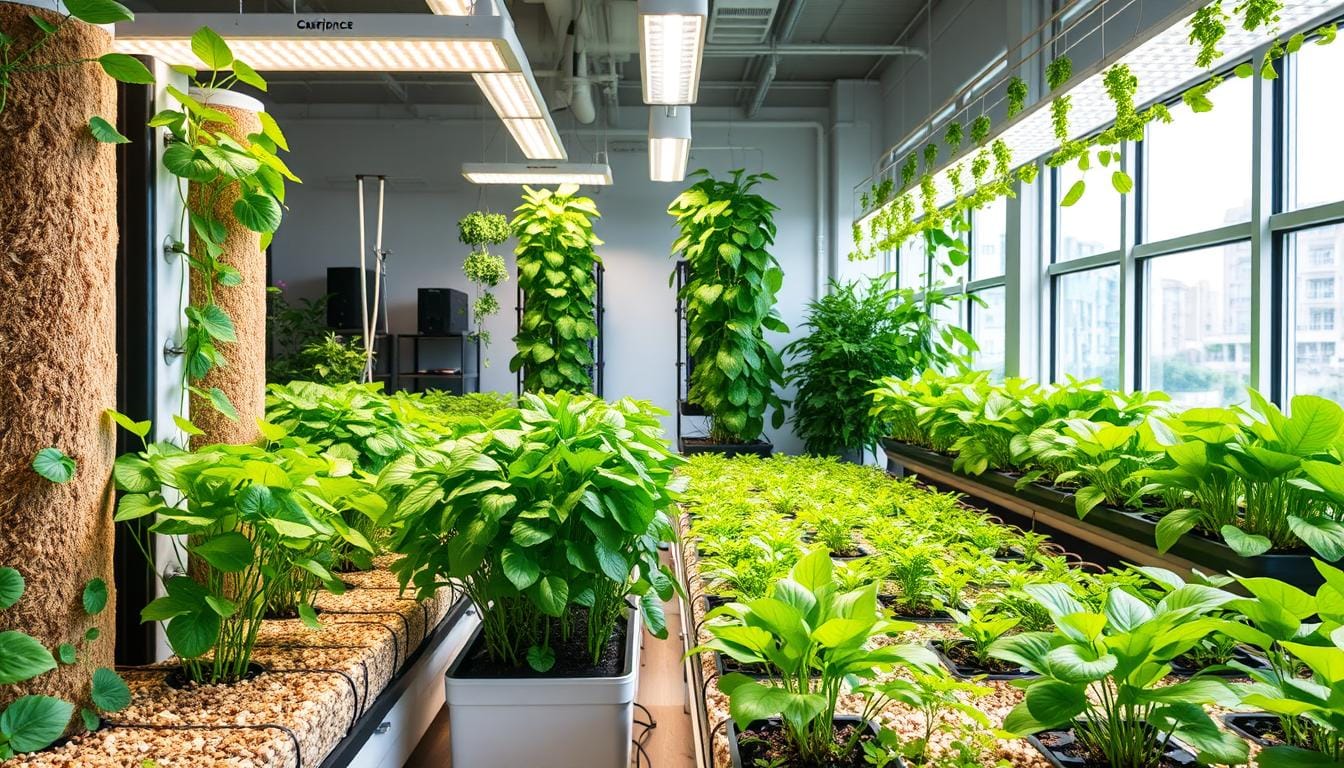I love indoor gardening and have found soilless methods like hydroponics amazing. They make growing plants cleaner and more controlled. This guide will show you the best six soilless growing media for indoor gardening.
Key Takeaways
- Soilless methods like hydroponics can make plants grow 20% faster and yield 25% more than soil gardening.
- There are many hydroponic systems, each good for different plants. They include wick, deep water culture, ebb and flow, and nutrient film techniques.
- Choosing the right growing media like Rockwool, coco coir, perlite, and vermiculite is key for healthy plants and nutrients.
- Keeping the pH levels between 5.4 and 7 is vital for a thriving hydroponic garden.
- Hydroponics can be more efficient and cost-effective than traditional soil gardening for indoor plants.
Understanding Soilless Growing Media Fundamentals
Soilless cultivation is a new way to grow plants without soil. It uses nutrient-rich solutions and growing media to feed plants. A hydroponic system has a water reservoir, nutrient-rich water, and special equipment like channels and pumps.
Benefits of Soilless Cultivation
Soilless growing media have many benefits. They are great for indoor and urban gardens. These systems allow for year-round growing and use space well.
They also help plants grow faster and stronger. This can lead to higher yields than traditional soil gardening.
Key Components of Hydroponic Systems
- Water reservoir: Holds the nutrient-rich solution that feeds the plants
- Grow channels or trays: Provide a stable platform for the plants and growing media
- Air pumps and stones: Oxygenate the water to support healthy root development
- Nutrient solutions: Specially formulated to supply all the essential elements plants need
Essential Nutrients in Soilless Growing
Hydroponic systems give plants the right nutrients. They have macronutrients like nitrogen and micronutrients like iron. This helps plants grow well.
“Hydroponics in urban areas can help optimize space usage through vertical systems, transforming unused spaces into productive growing zones.”
Soilless cultivation has its challenges. It can be expensive to start and needs special knowledge. But, it’s a good choice for those who want to grow plants sustainably.
Rockwool: The Professional’s Choice for Indoor Gardens
In the world of vertical farming and horticultural techniques, rockwool stands out. It’s a top pick for indoor gardening pros. This growing medium brings many benefits to the table.
Rockwool is made in high temperatures, creating a clean, pest-free environment. It’s full of air, even when wet, giving plants the right mix of water and oxygen. Plus, it’s a clean slate for nutrients and pH levels, perfect for hydroponics.
Rockwool comes in many forms, like blocks, slabs, and fibers. This meets the varied needs of gardeners. It also keeps root temperatures steady, helping plants grow better.
Some might think rockwool is bad for the environment, but it’s made from common rocks. It’s safe to use with the right precautions, making it a good choice for gardeners.
The debate between rockwool and coco coir is ongoing. Coco coir holds a lot of water, while rockwool keeps temperatures stable. The best choice depends on what you need and want to spend.
| Rockwool | Coco Coir |
|---|---|
| Excellent insulation properties | Superior water retention |
| Inert material for precise nutrient control | Efficient nutrient management due to porous structure |
| Stable pH levels | Biodegradable and sustainable |
| Durable and long-lasting | Cost-effective and accessible |
Rockwool is a solid choice for anyone into vertical farming. It’s trusted by pros in the horticultural techniques field.
Coco Coir: Sustainable and Versatile Growing Medium
Coco coir is a top pick for sustainable agriculture and urban farming. It comes from coconut husks and is good for both indoor and outdoor gardens. It’s eco-friendly and offers many benefits.
Processing and Preparation Methods
To make coco coir ready for use, it goes through a detailed process. It’s washed, buffered, and sterilized to remove bad stuff. This makes it a clean, pH-neutral base for plants to grow.
Water Retention Properties
Coco coir is great at holding water. Its fibers and structure keep moisture in, so plants don’t dry out as fast. It’s perfect for places with dry soil or climates, helping plants thrive with less water.
Nutrient Management in Coco Coir
Coco coir doesn’t have many nutrients on its own. But, it’s easy to add what plants need. Its neutral pH lets growers adjust nutrient levels for different plants. Mixing it with compost or perlite creates a custom growing mix for sustainable agriculture.
“Coco coir has gained immense popularity among hydroponic enthusiasts due to its excellent water retention properties and natural ability to support plant growth.”
Coco coir is becoming more popular for its eco-friendly and efficient growing qualities. It fits well into soilless cultivation systems, from hydroponics to potting mixes. Its renewable and low-impact nature appeals to eco-conscious gardeners and urban farmers.
Perlite and Vermiculite: Lightweight Aeration Solutions
In plant growth systems and horticultural techniques, perlite and vermiculite are key. They help create the best growing space for indoor gardens. These materials improve aeration and drainage in soilless growing media.
Perlite is made from volcanic glass that expands a lot when heated. It becomes very porous and lightweight. This makes it great for improving drainage and aeration in growing media.
Vermiculite is a naturally occurring mineral known for its ability to expand significantly when subjected to heat, making it a versatile material in various applications. It becomes very absorbent and lightweight. It’s perfect for keeping soil moist and improving root growth.
- Perlite is good for plants that need well-draining soil, like succulents.
- Vermiculite is better for plants that need more moisture, like seedlings.
- Using both perlite and vermiculite creates a balanced growing medium. It meets many indoor gardening needs.
Choosing the right growing medium depends on your plants’ needs and your gardening style. Using perlite and vermiculite can make your indoor plants thrive. They offer an optimal balance of aeration and moisture, ensuring ideal conditions for healthy plant growth.

Hydroponic vs. Soil Growing: A Comprehensive Comparison
The debate between hydroponic and soil-based growing systems is heating up in sustainable agriculture. Both have their own benefits. Knowing the differences can help you choose the best for your indoor garden.
Growth Rate and Yield Differences
Hydroponics often beats soil growing in growth rates and yields. Plants get nutrients directly, leading to faster growth. They can grow 20-30% faster than soil-grown plants.
Hydroponics can also produce up to 45 times more per square foot than traditional farming.
Resource Efficiency Analysis
Hydroponics is a water-saving superstar. It uses up to 98% less water than traditional farming. This characteristic makes it ideal for use in dry regions or areas with limited water availability.
It also cuts down on food transport, lowering carbon emissions. This makes hydroponics a greener way to grow food.
Cost and Maintenance Factors
Hydroponics might cost more to start, but they save money in the long run. They control nutrient levels well, reducing the need for constant soil and nutrient replenishment. But, they need regular checks on pH, EC, and sometimes new parts.
Soil growing is cheaper to begin with. It uses common gardening tools and materials. But, it might need more money for pest control, disease prevention, and soil care.
Choosing between hydroponics and soil growing depends on your needs, budget, and goals. Both have benefits. The best choice depends on your space, yield goals, and commitment to green farming.
Clay Pebbles: Premium Medium for Root Development
Creating a thriving indoor garden starts with the right growing media. Clay pebbles are a top choice for gardeners. They are used in hydroponic systems and offer great benefits for roots and plant health.
Clay pebbles are great at keeping roots healthy by providing good air flow. This stops water from pooling and keeps roots well-oxygenated. They also don’t change the pH of the soil, making them good for many plants.
Another big plus is that clay pebbles can be reused. Unlike other media, they don’t break down quickly. This saves money and is better for the environment, making them a green choice for gardeners.
In hydroponic systems, like ebb and flow setups, clay pebbles are perfect. They drain water well, keeping plants just right in terms of moisture. This is key for healthy plants.

Clay pebbles are a great choice for anyone starting or improving their indoor garden. They support strong root growth, offer good air flow, and are eco-friendly. These pebbles can help you grow amazing indoor gardening, plant growth systems, and horticultural techniques at home.
Nutrient Film Technique (NFT) Systems and Media
The Nutrient Film Technique (NFT) is a top hydroponic method for indoor and urban farming. It uses a constant flow of nutrient-rich water over plant roots. This ensures plants always have the nutrients, water, and oxygen they need.
NFT systems work great for shallow-rooted crops like lettuce, herbs, and strawberries. They are a favorite in vertical farming and controlled environment agriculture.
Best Plants for NFT Systems
NFT systems do well with many plants, but they love crops with shallow roots. Some top picks include:
- Leafy greens (e.g., lettuce, kale, spinach)
- Herbs (e.g., basil, mint, cilantro)
- Strawberries
- Small vegetables (e.g., cherry tomatoes, micro-greens)
Maintenance Requirements
Keeping an NFT system running smoothly needs careful attention. Important tasks include:
- Regularly cleaning the channels to avoid clogs and algae
- Regularly checking and adjusting the nutrient solution’s pH and EC levels is essential for maintaining optimal plant health and growth
- Ensuring the right flow rate, usually between 1/4 to 1/2 gallon per minute per channel
- Providing enough aeration to the roots, either with an air pump or the system’s design
Common Troubleshooting Tips
Even with NFT systems, problems can pop up. Here are some tips to fix common issues:
- Clearing clogged channels by removing debris and algae
- Stopping root mat formation to keep nutrient and water flow open
- Adjusting the system’s slope and flow rate for better nutrient delivery
- Keeping the right water and nutrient levels to avoid shortages or toxicity
Knowing how to care for NFT systems helps growers get the most out of them. This is true for vertical farming, urban farming, and controlled environment agriculture.
Deep Water Culture and Growing Media Selection
Deep Water Culture (DWC) systems are a favorite among indoor growers. They keep plant roots in a nutrient-rich, oxygenated water solution. This gives plants the minerals and oxygen they need.
The growing media in DWC systems mainly helps hold the plants in place. They don’t provide nutrients. Some common options include:
- Net pots filled with clay pebbles or rockwool cubes
- Oasis or coco coir mix
- Peat moss
DWC systems use grow rafts to hold plants in the water. They also have oxygenated reservoirs and air pumps. This setup helps plants grow fast and produce a lot, perfect for plants like lettuce and herbs.
DWC has many benefits. It saves water, increases crop yields, and controls nutrients better. It also reduces the risk of diseases. Working with experts like Hydronov can help optimize DWC systems for better results.
| Hydroponic vs. Soil Growing | Advantages | Disadvantages |
|---|---|---|
| Hydroponic (DWC) |
|
|
| Soil-based |
|
|
Understanding DWC systems helps indoor gardeners choose the best growing media. This is key for successful plant growth systems and indoor gardening.
Optimizing Growth Conditions in Soilless Systems
For controlled environment agriculture and horticultural techniques in sustainable agriculture to succeed, you need to control the environment well. Keeping the right pH levels and electrical conductivity (EC) is key. This ensures plants get the nutrients they need and grow well in soilless systems.
pH and EC Management
The pH in soilless growing media should be between 5.5 and 6.5 for best nutrient absorption. It’s important to monitor and adjust the nutrient solution’s pH to avoid nutrient problems. Also, managing the EC helps keep the right amount of nutrients for plants to thrive.
Temperature Control Strategies
Temperature is very important in controlled environment agriculture. Most plants do best in temperatures between 65-75°F (18-24°C). Growers use climate-controlled rooms, heated benches, and ventilation to keep the temperature just right for growth.
Light Requirements and Solutions
Plants need enough light to grow well in soilless systems. LED grow lights are a good choice because they’re energy-efficient and can be adjusted for different growth stages. Managing light, including how long, how bright, and what color, can really help plants grow better and stronger.
By managing pH, EC, temperature, and light, growers can create the best conditions for plants in sustainable agriculture and horticultural techniques in soilless systems.
| Factor | Optimal Range | Impact on Plant Growth |
|---|---|---|
| pH | 5.5 – 6.5 | Ensures proper nutrient availability and uptake |
| Electrical Conductivity (EC) | 1.0 – 2.5 mS/cm | Maintains ideal nutrient concentration for healthy plants |
| Temperature | 65 – 75°F (18 – 24°C) | Supports optimal growth and development |
| Lighting | Tailored spectrum and duration | Enhances photosynthesis and yield |
Conclusion
Soilless growing media bring new ways to garden indoors and grow food sustainably. Options like rockwool and coco coir are perfect for different plants and setups. Hydroponic vs. soil growing often means faster growth and more produce, but they need more money and care at first.
Urban farming and indoor growing are getting bigger, and soilless methods are key. They save a lot of water, cut down on pesticides, and use space well. This makes them a bright spot for green and efficient farming.
If you garden indoors or are new to it, checking out soilless media can open up new chances for big harvests. Gaining a clear understanding of the benefits and drawbacks of each option enables you to choose the most suitable solution tailored to your space and goals.

